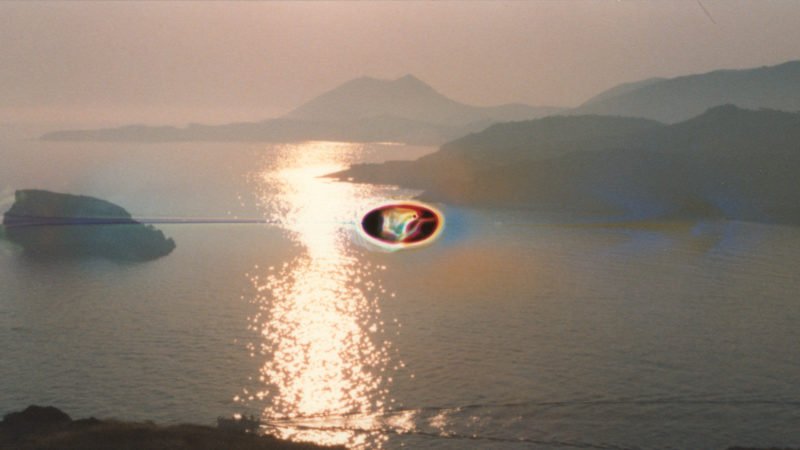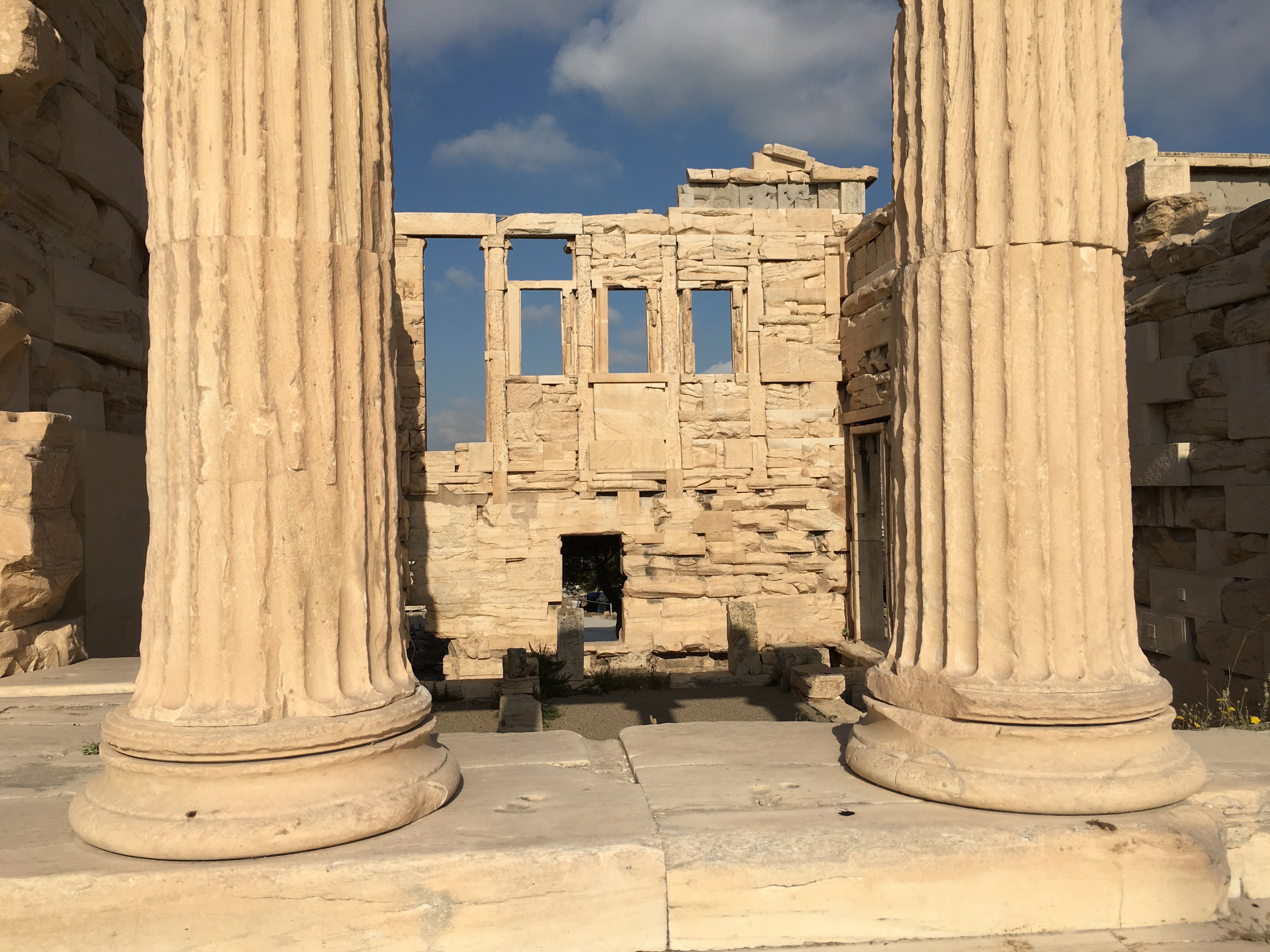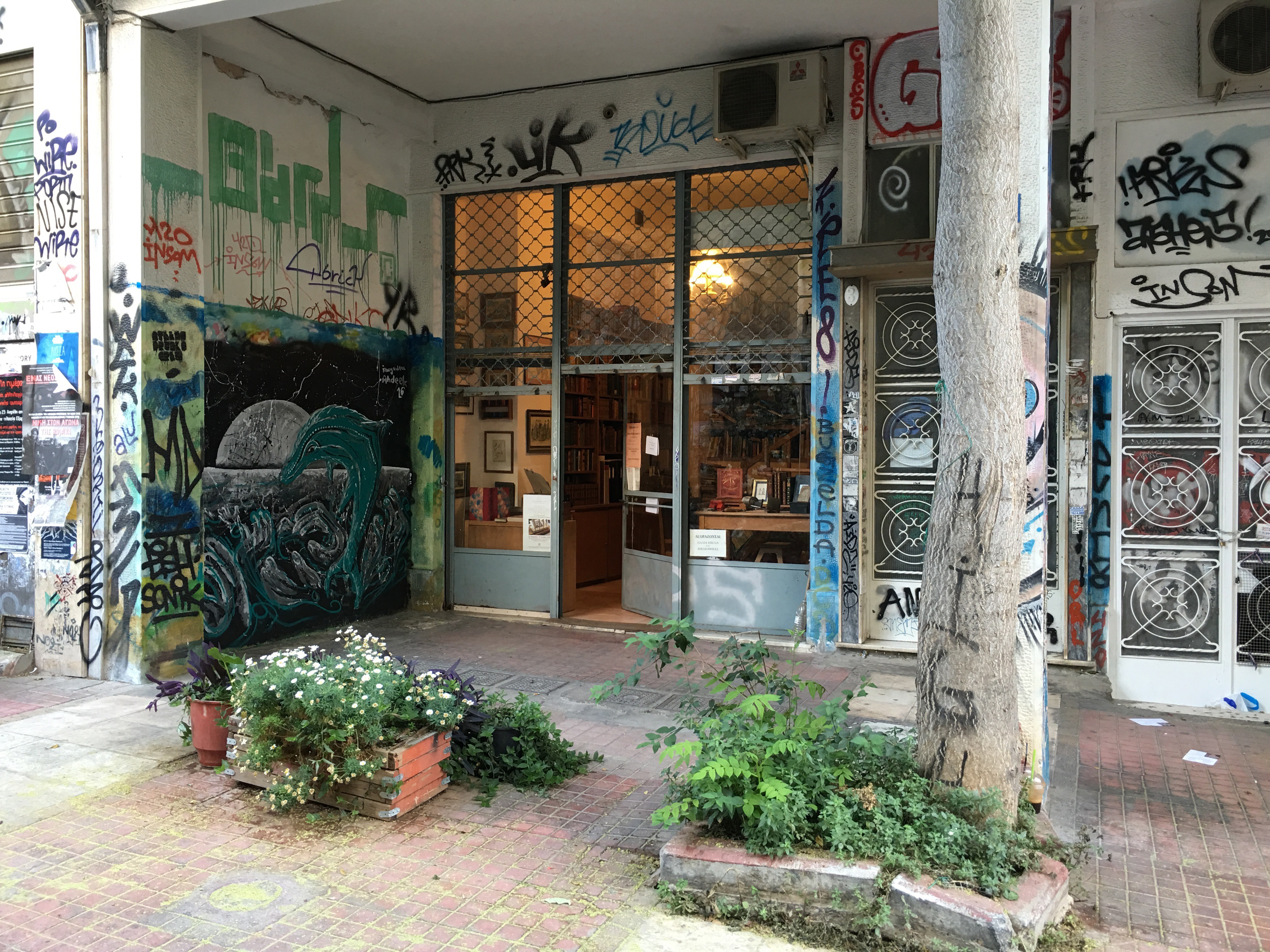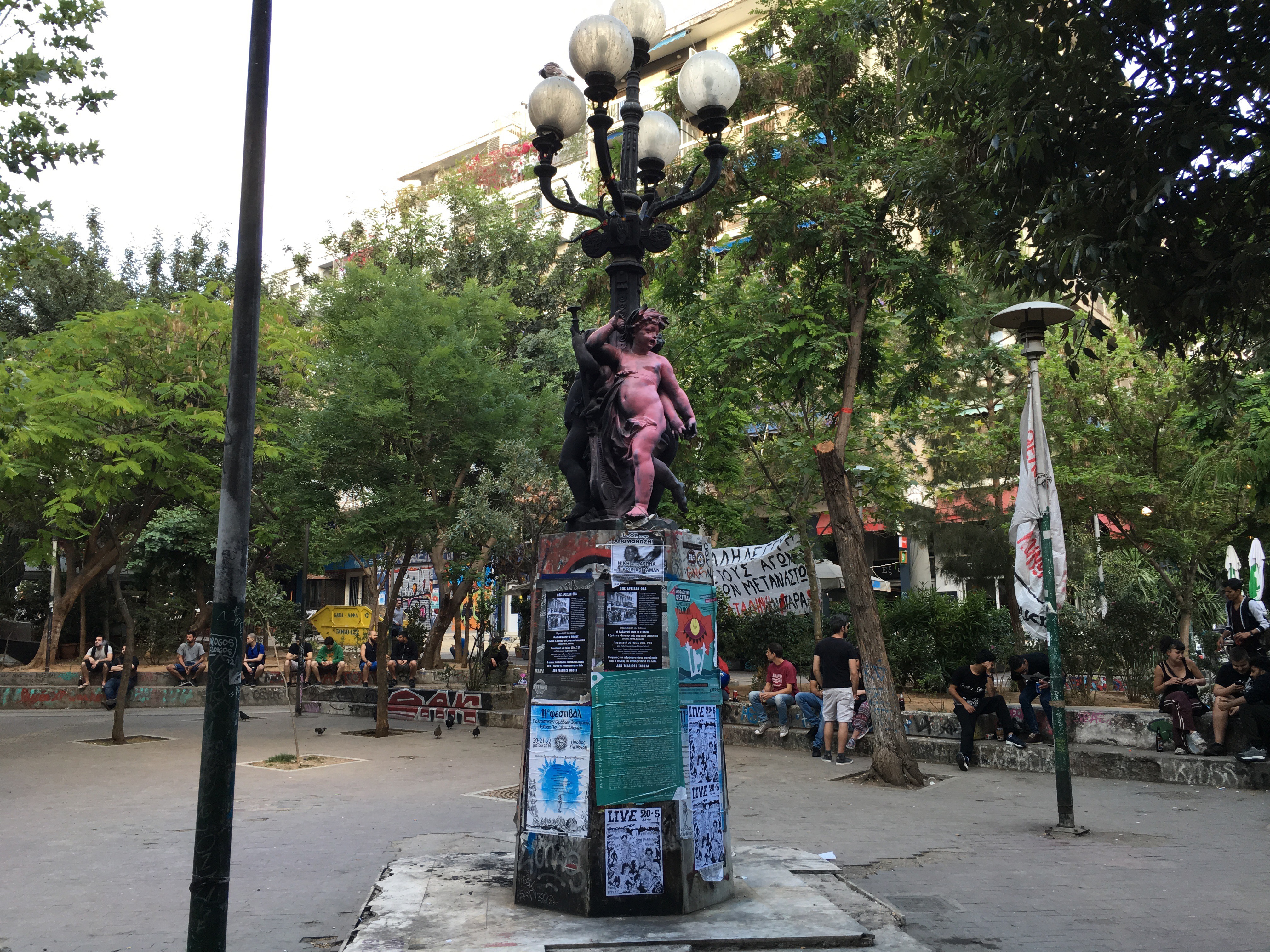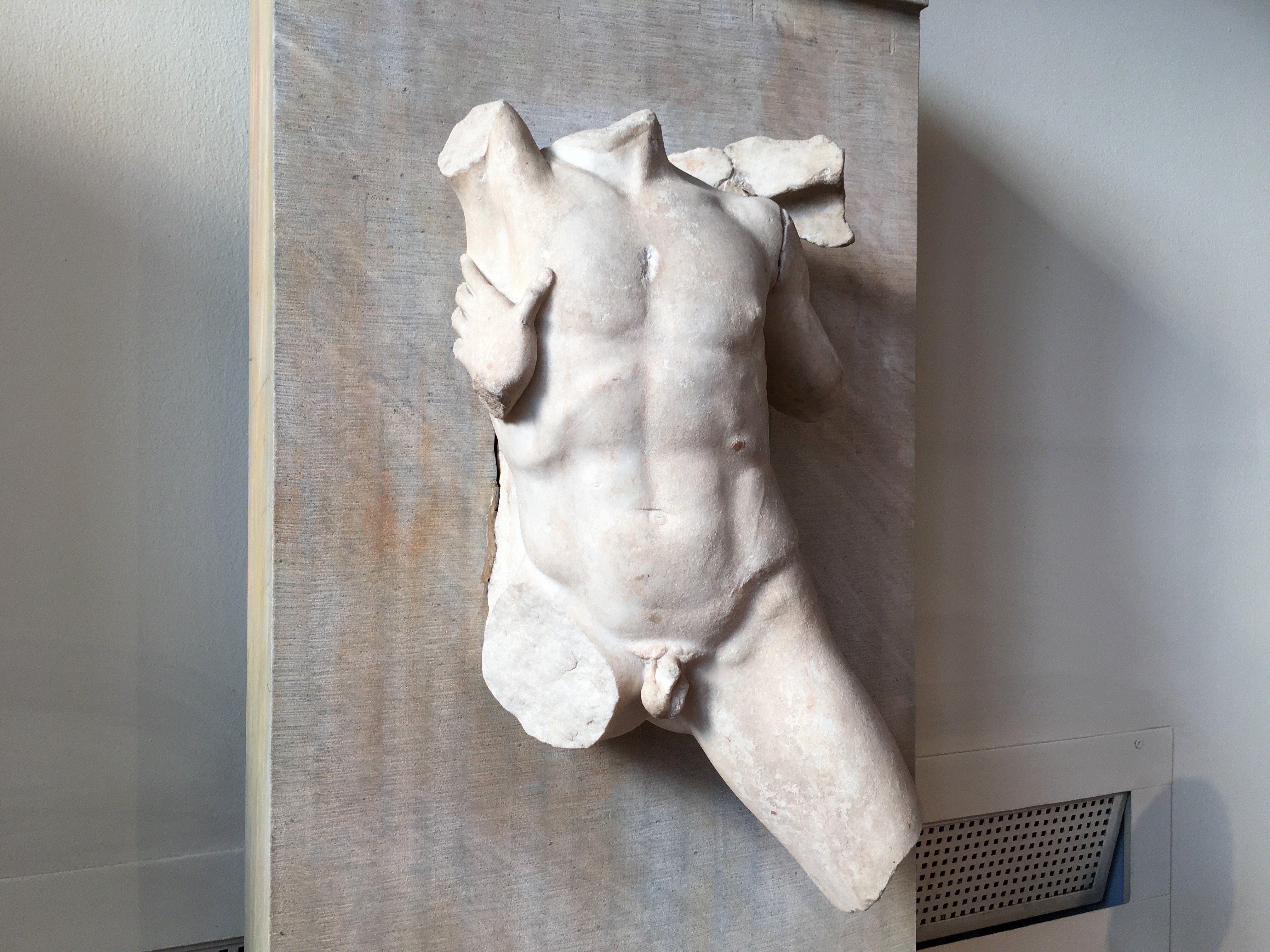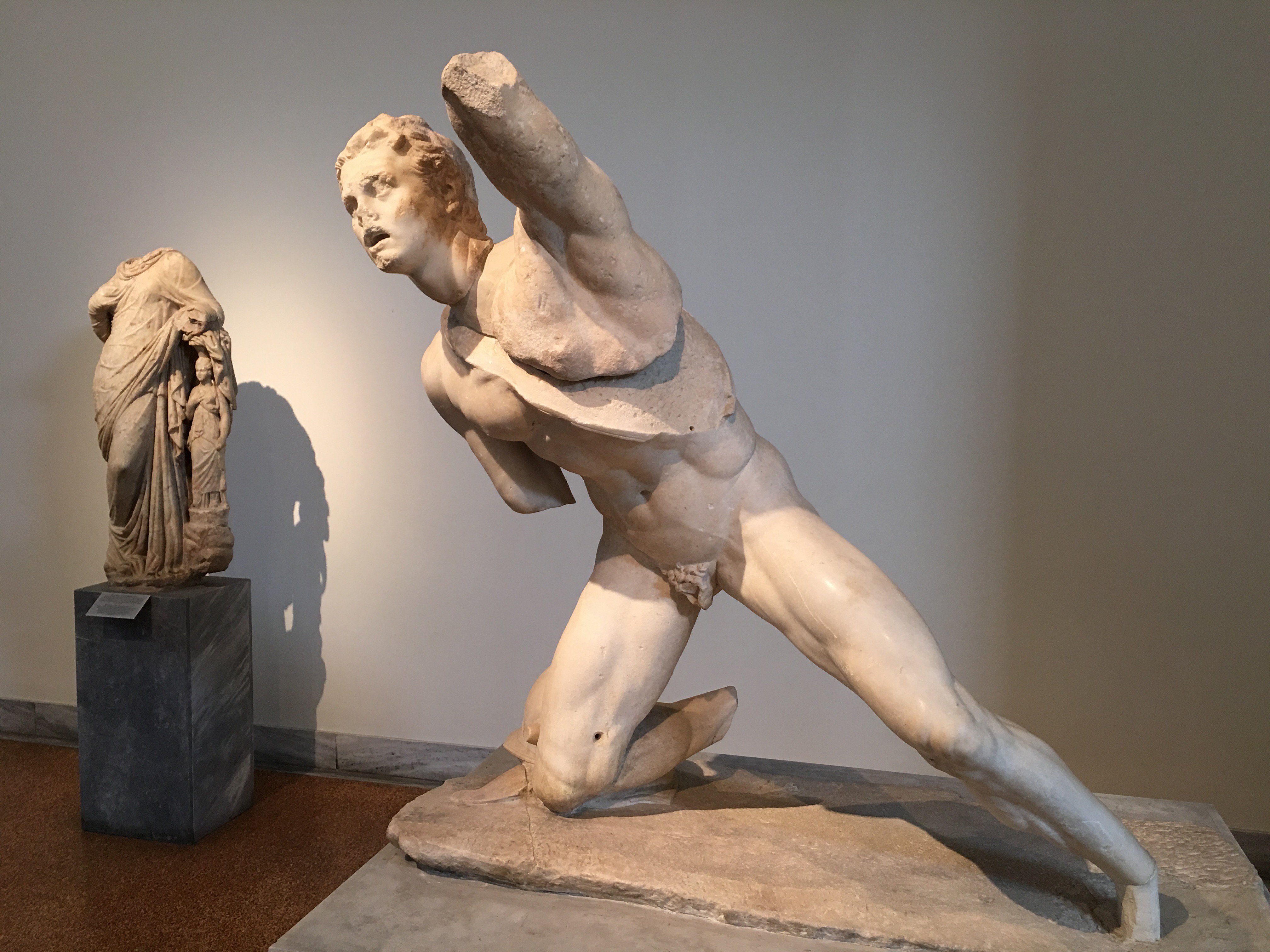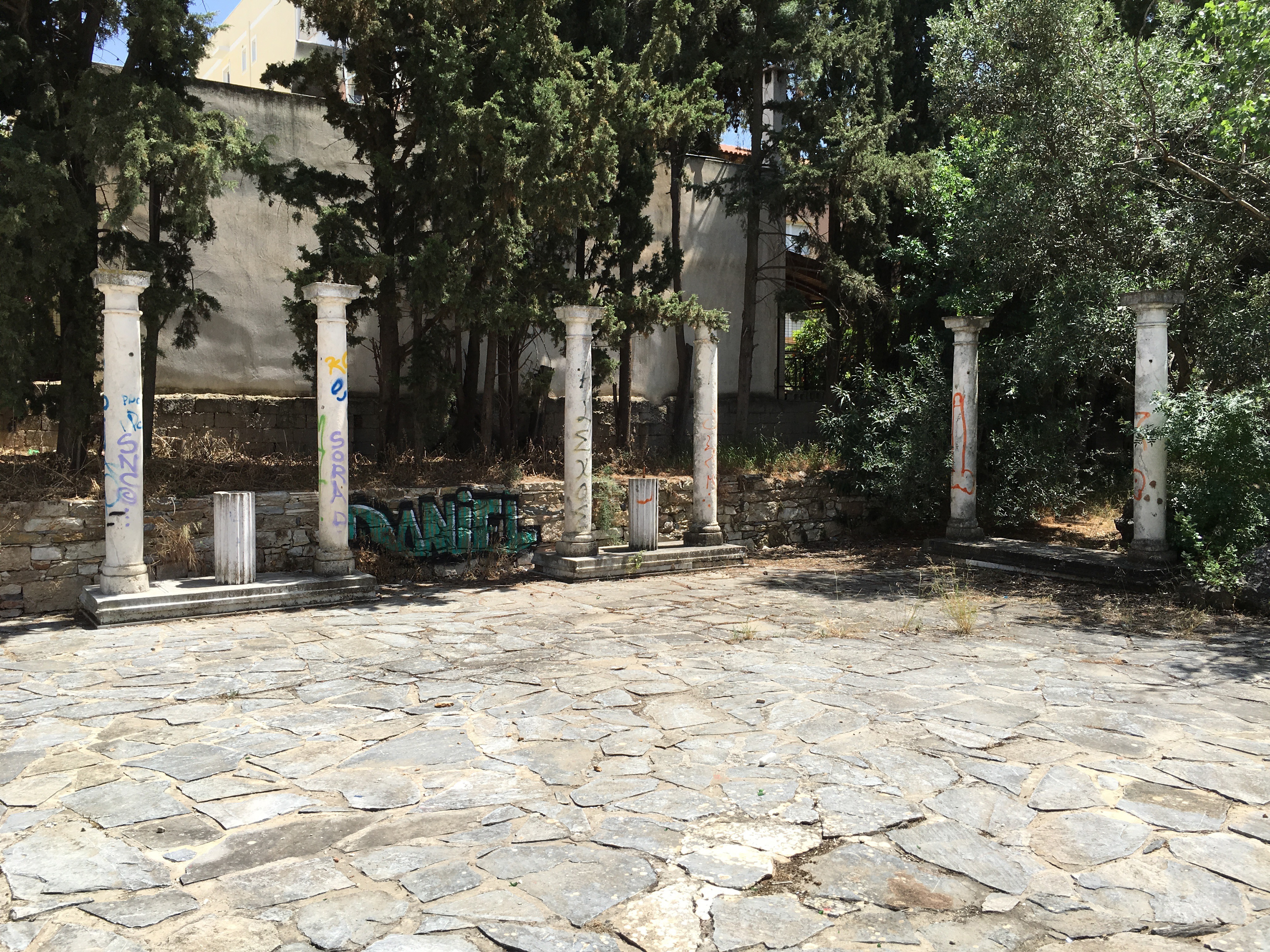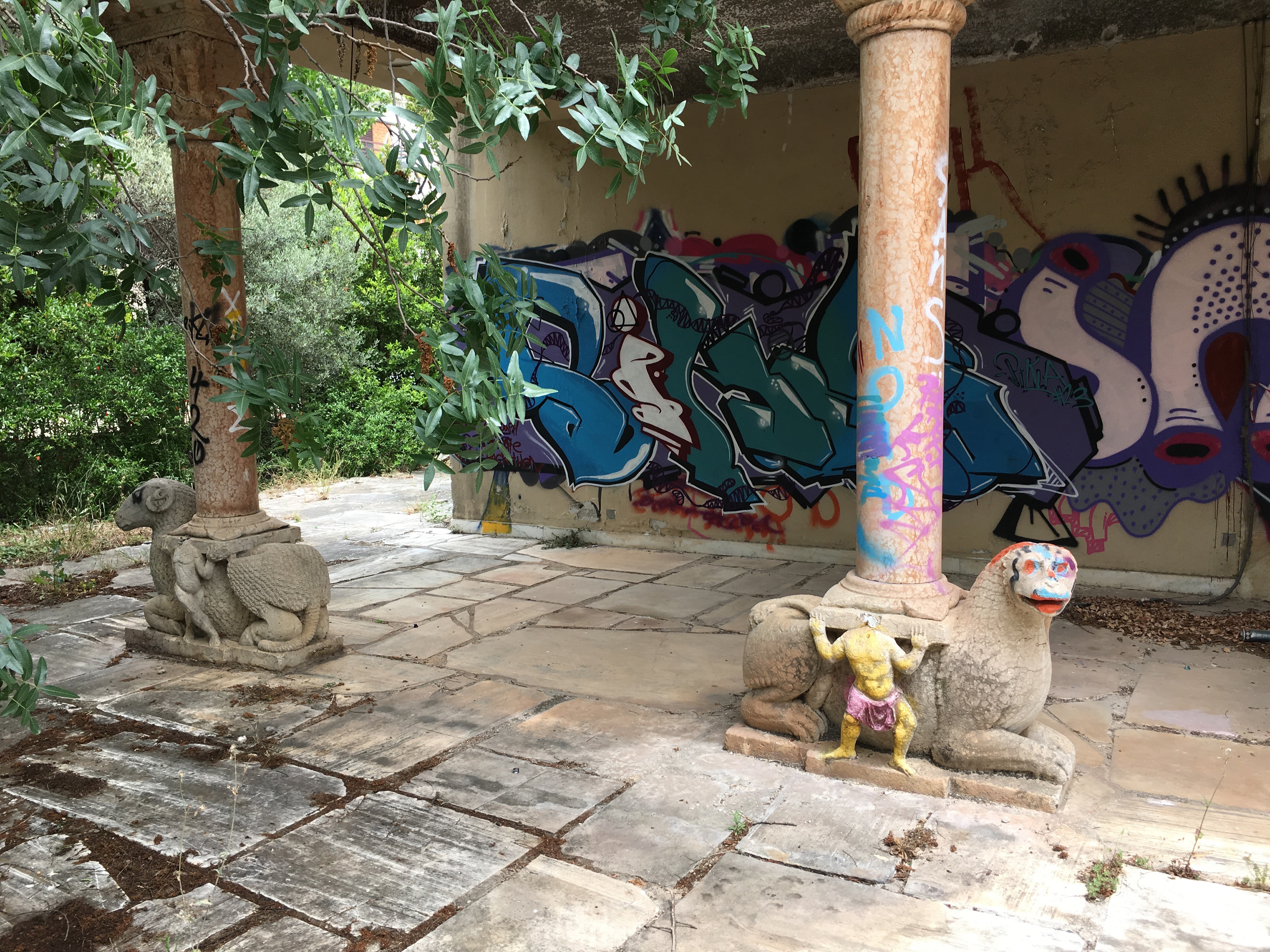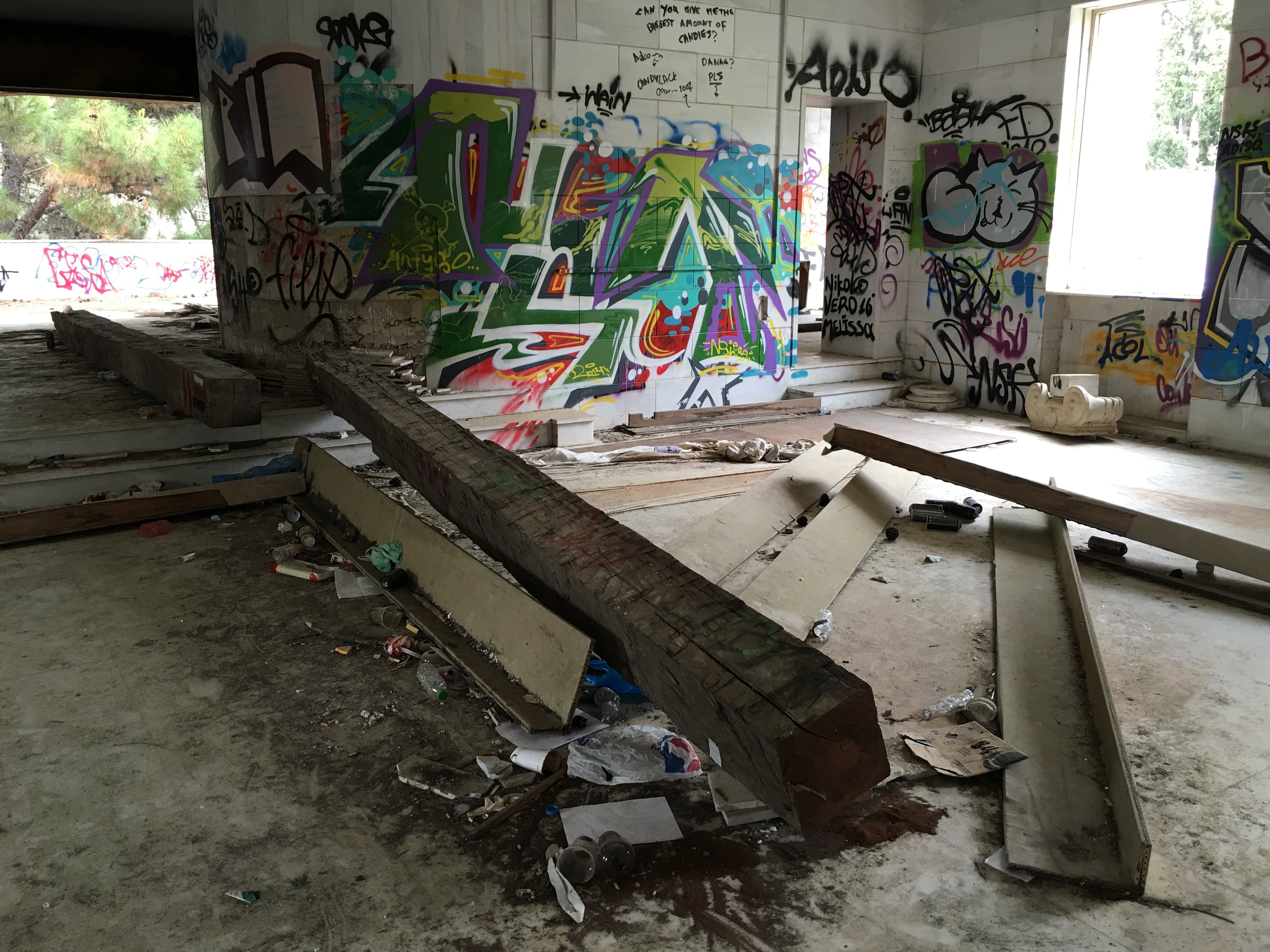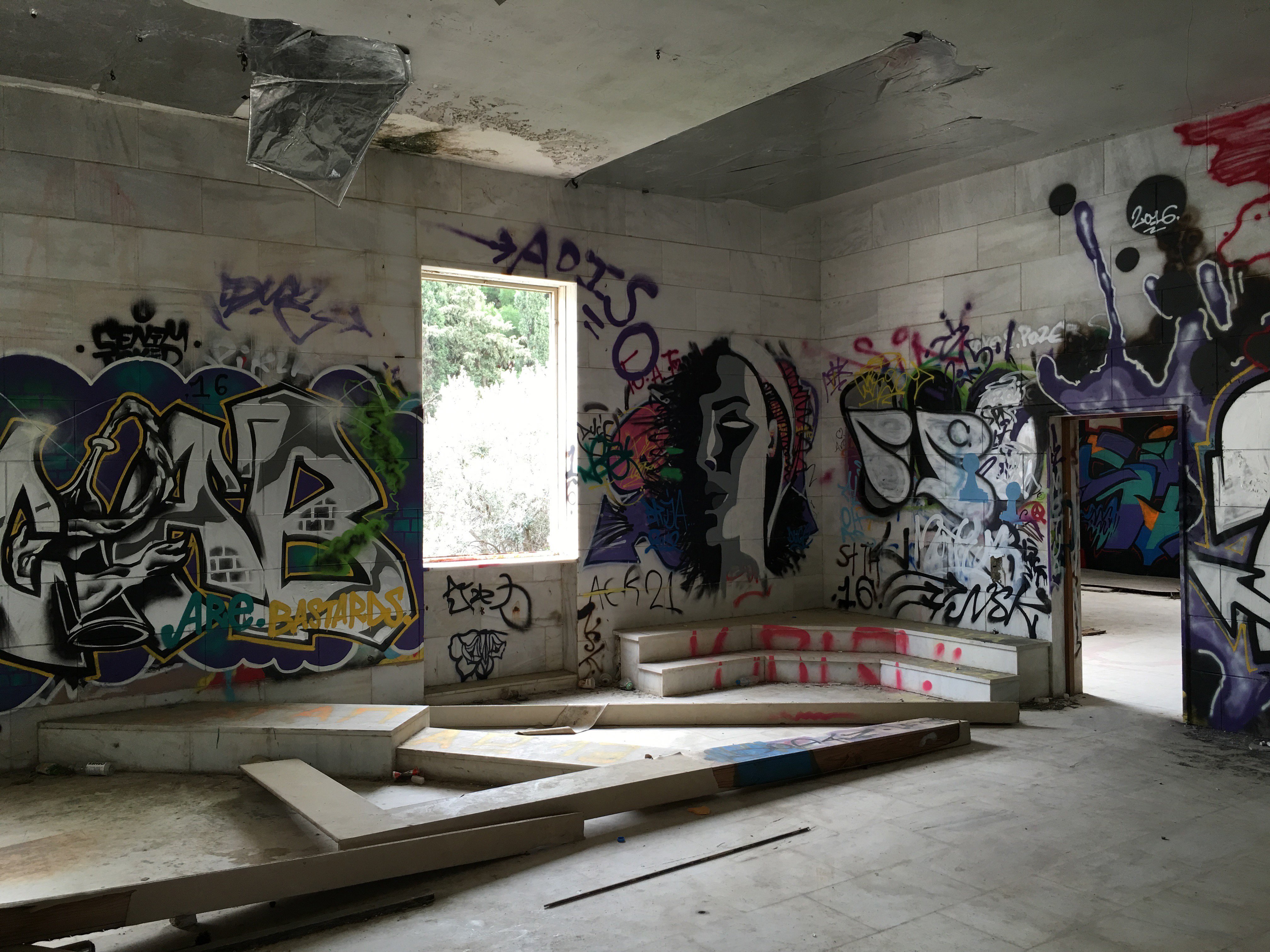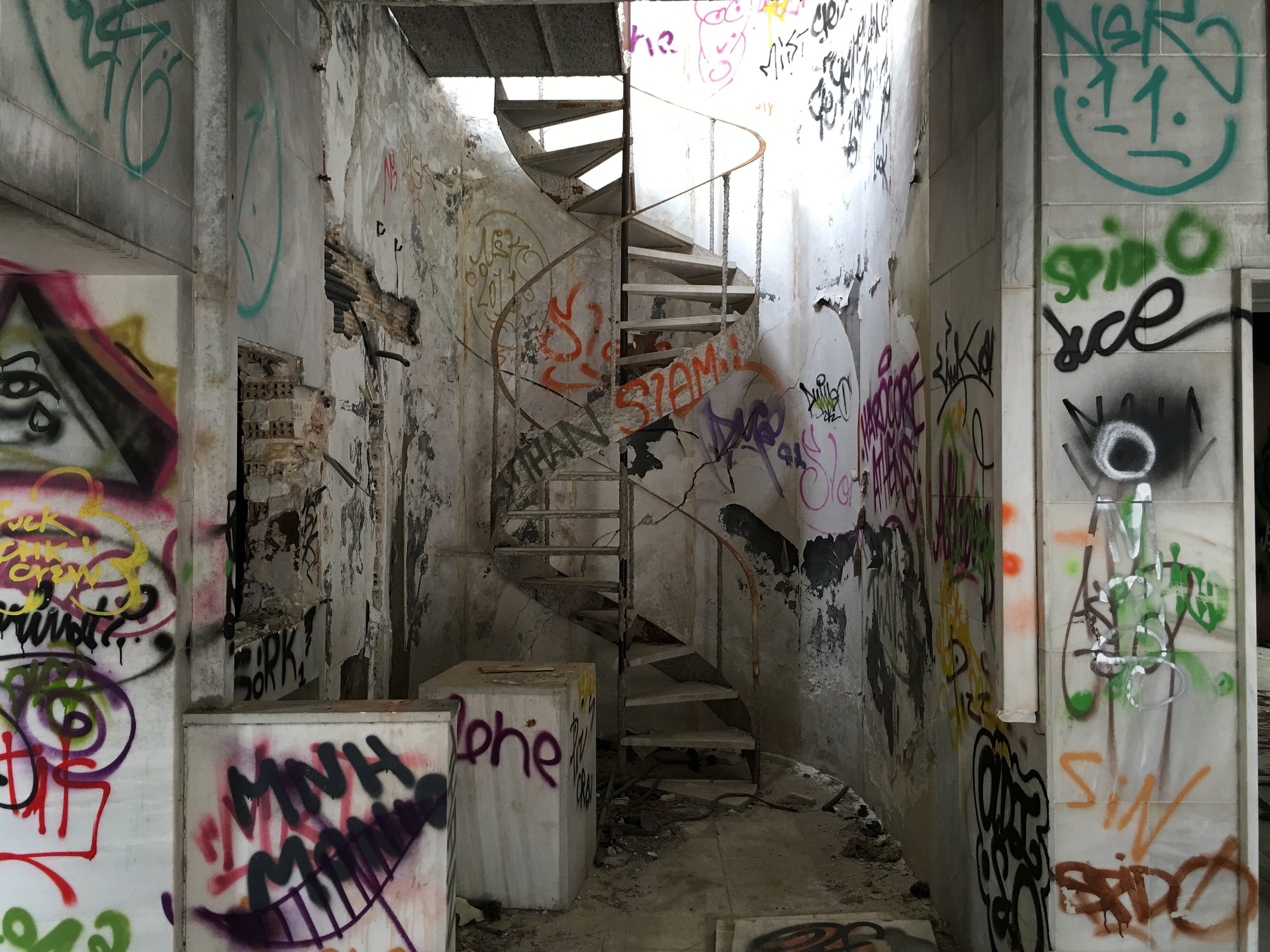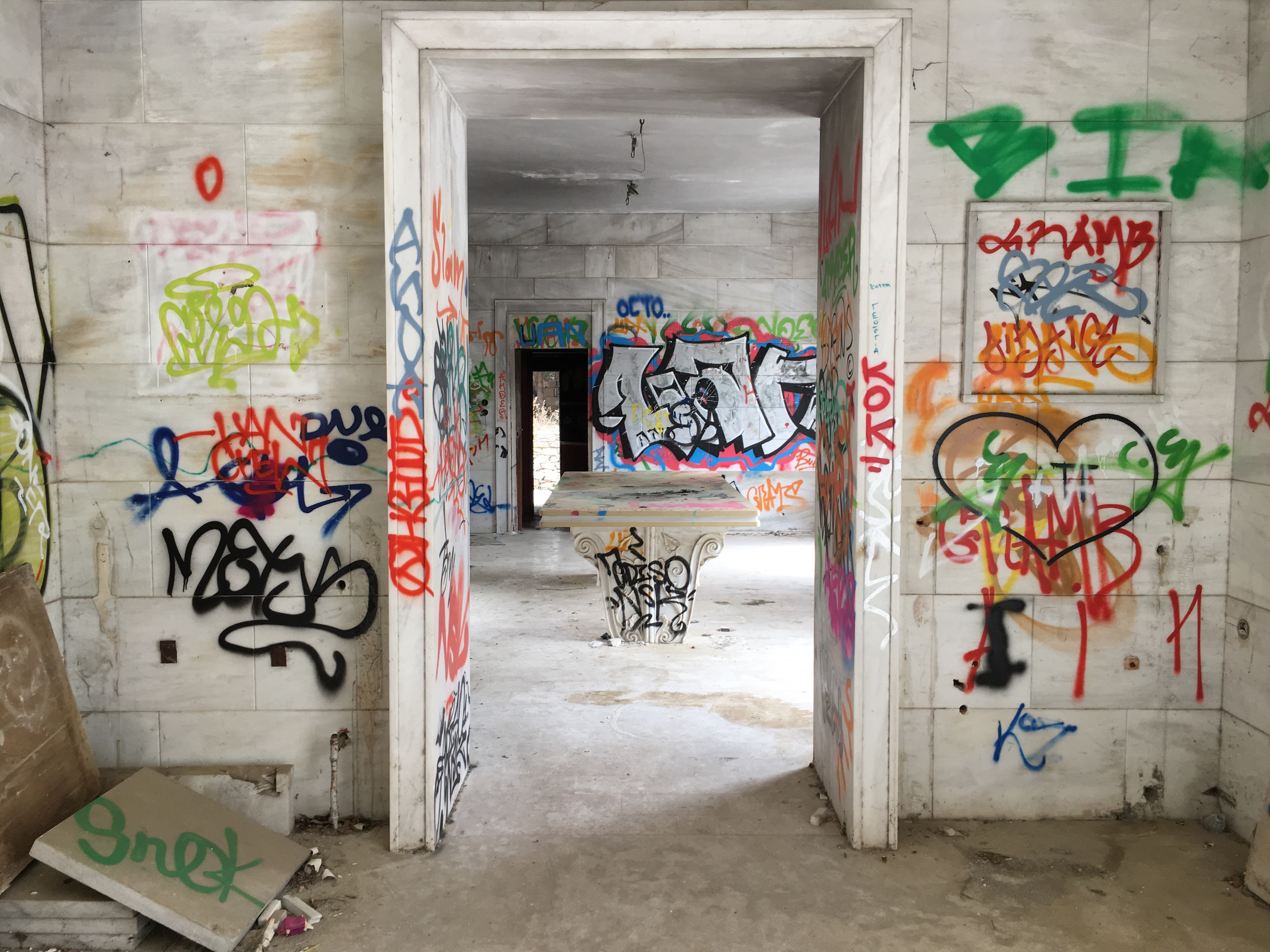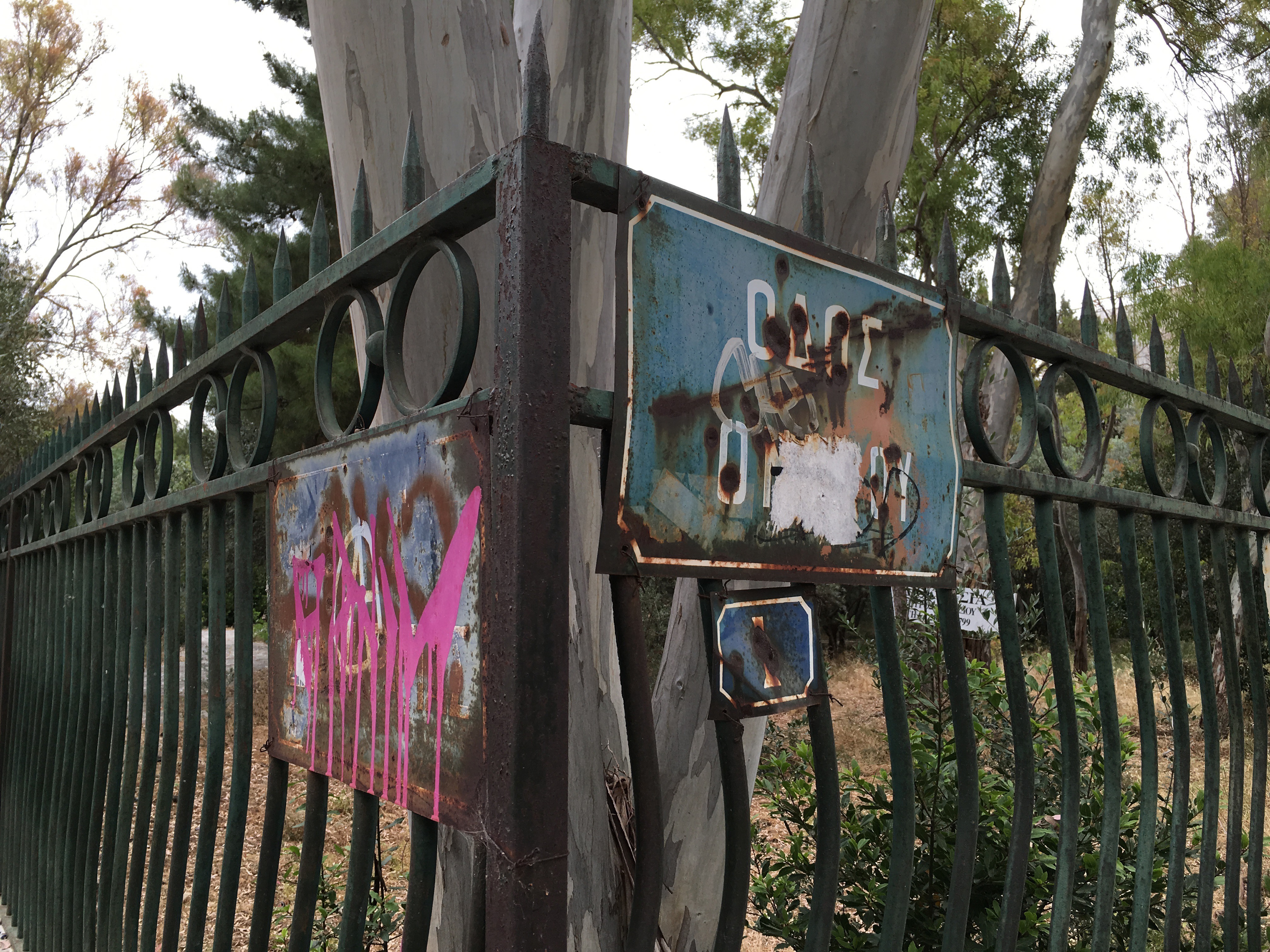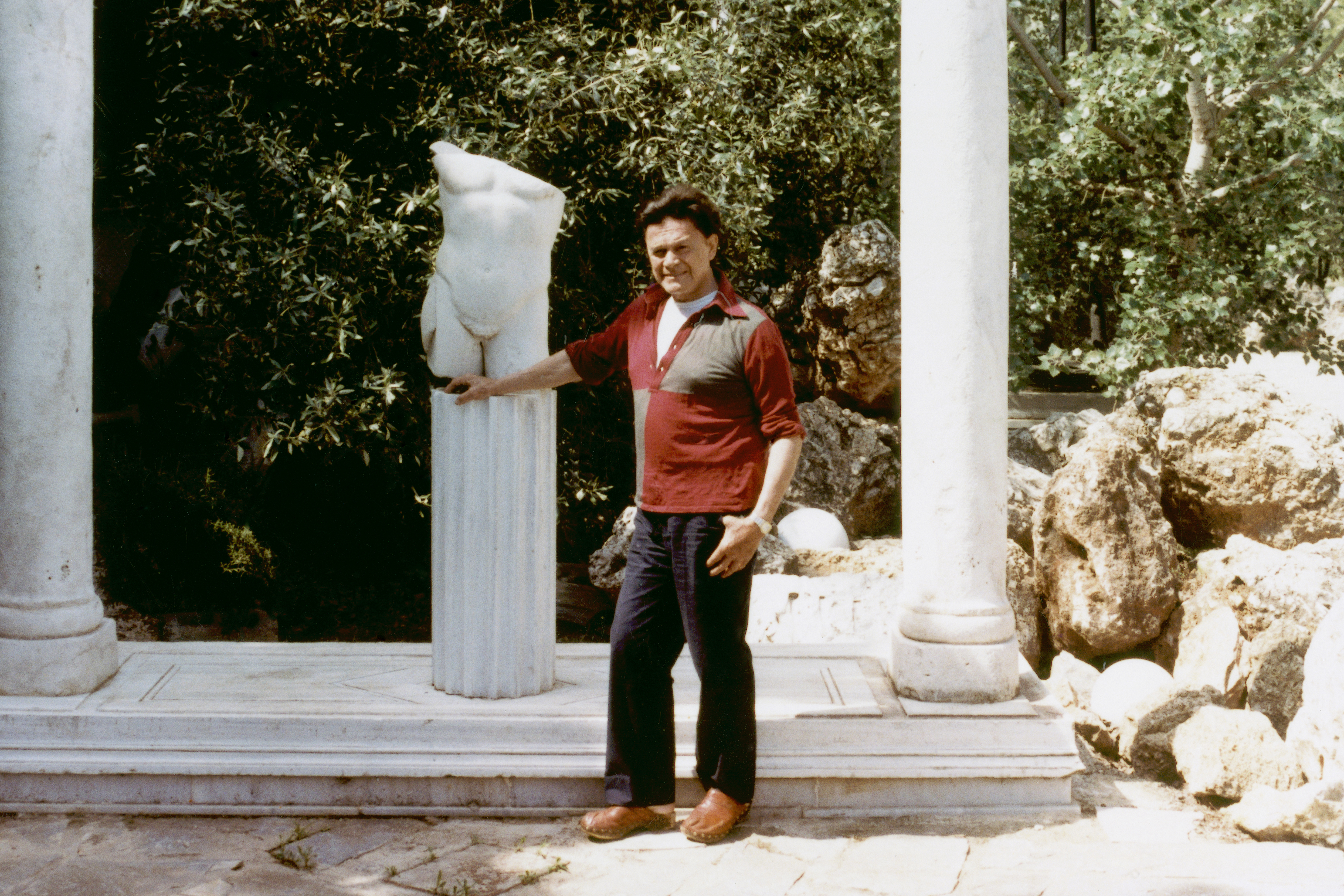William E. Jones is a writer, artist, and filmmaker with as wide a range of themes and influences in his oeuvre as mediums at his disposal. He’s never shied away from the personal, either, or from putting the spotlight on unsung (or undersung) figures in the art or literary worlds. With his most recent work, Fall into Ruin, he embraces both of these tendencies.
Fall into Ruin is a half-hour film, narrated by Jones himself, focusing on the Greek art collector Alexander Iolas (1907–1987), who gave Andy Warhol his first solo show in 1952, dealt in the works of the surrealists, and built a formidable home/gallery combination called Villa Iolas in a suburb of Athens. Jones had a life-changing interaction with Iolas when he was an undergraduate, and recently returned to Greece to survey what’s become of Villa Iolas.
After watching this hypnotic film several times from the comfort of my own home, I spoke with Jones about all things Iolas, the art world, and the many worlds Jones’s works inhabit.
First exhibited at the Modern Institute in Glasgow, Fall into Ruin will be showing at David Kordansky Gallery in Los Angeles from July 15 to August 26, 2017.
—Jordan A. Rothacker for Guernica
Guernica: I’ve watched the film a few times now at home, without the context of a museum or gallery, but I really enjoyed it. How was its reception in Glasgow, at The Modern Institute?
William E. Jones: I’m afraid I’m not very good at judging my own work’s reception; perhaps that’s better left to others anyway. I was ill when I came to Glasgow for the installation of the show, and I lost my voice. When it came time to give my artist’s talk, I did not have my full voice, and to my chagrin, this condition persisted for two months afterward. During the spring I spent whole days in silence, resting my voice and hoping that my vocal cords would heal. The only way I could express myself verbally was by writing, and I did a lot of it. Eventually, my voice returned, and now I have many pages of prose to show for it, so I guess some good came of the experience.
Guernica: You mention in the book Between Artists: Thom Andersen/William E. Jones (ART Press, 2013) a desire to do more essayistic films, and this would fit that definition. It’s a monologue; you speaking over a succession of photographs of Villa Iolas during your first visit in the summer of 1982, when Iolas lived there and displayed pieces of his art collection, photographs of Greek antiquities in Athens in various states of wholeness, and photographs of the Villa, now in ruins and covered in graffiti. Your monologue feels somewhere between an essay and a prose poem, actually, with this visual support providing more texture than narrative. It’s a very soothing experience, with a bittersweetness to it. A certain melancholy.
William E. Jones: The first sequence of images in your list, the 1982 photographs of Villa Iolas, actually comes last in the film and serves as its culmination. But your shuffling of their order is indicative of a major strategy of the film: I never directly show what I am talking about. I avoid illustration completely, even though at times I have the exact visual materials to illustrate my voice-over narration. This strategy has a couple of effects I can explain. First, it engages the spectator intellectually and creates suspense—attentive viewers ask, “Will I see Iolas’s house as the narrator saw it when young?” and at moments think, “Oh yes, I saw a picture of that earlier.” The film becomes whole only in the mind of the spectator; this is the case with every film, but I choose to emphasize the process. Second, doing this mental work creates a certain mood. You call it bittersweet or melancholy, but I think of it as engaged, a bit like the experience of a reader absorbed in a book. The film requires an intense quality of attention, the way reading does, and it is lost on distracted or disengaged spectators.
Guernica: That does get to the heart of my experience. The first time I watched it, I watched it twice in a row—hence my confusion of image order, maybe—but that might have given me more of the gallery experience, of approaching a film midstream already and just letting it finish and start over, reconstructing it in my head.
William E. Jones: I made Fall into Ruin with a running time of thirty minutes exactly, so when it plays on a loop, screenings begin every half hour, precisely. That way gallery visitors can show up at regular intervals and treat the experience as a film screening. Your question brings up an important problem of showing moving-image works in a gallery space. Many spectators come to a film whenever they happen to arrive at the gallery, and this is potentially very confusing. I have made some films that can be seen and understood starting at any point in their duration, but I have also made more linear works; I haven’t devised a programmatic solution to this problem, nor has anyone else, to my knowledge. Filmmakers do the best we can to reach an art audience in imperfect circumstances.
The most problematic aspect that film brings into the gallery space is narrative, and this raises still more questions, some of them profound. Modernist art and avant-garde filmmaking were traditionally hostile to narrative. For instance, Clement Greenberg dismissed photography as literary, a hybrid medium not as pure as abstract painting or sculpture. Some filmmakers who aspired to a materialist practice, like Peter Gidal and Malcolm Le Grice, to name only the most extreme examples, rejected narrative as thoroughly as possible in their work. As someone from a later generation, I ask the question, why surrender narrative to the film industry, to comic books, and to advertising? I believe the difficulties in presenting narrative in an art context invite thought about new solutions, and should not be avoided.
Guernica: Do you find a kind of beauty in the graffiti that now fills the Villa Iolas? There is certainly something beautiful about your photographs of them.
William E. Jones: I am glad you found the photographs beautiful, but I do not share your opinion of the graffiti itself. Perhaps this sort of defacement is inevitable on the walls of any abandoned, yet accessible, site, and I’m sure many of the graffiti artists take their work seriously. I tend to see it as a gesture of disrespect toward Iolas’s memory. He was denounced in Greece’s tabloid press at the end of his life and died in disgrace. I see a bit of that same aggression toward him on the walls of his house. I admit this may be a personal response, because I knew the man and saw the house while it was intact. Revisiting the place in its ruined state had an effect on me like the impact of a physical blow.
Guernica: Athens is a city full of ruins, notably ancient ruins (which your film depicts in public and in museums), and here is this twentieth-century villa that has now joined them. An example of impermanence with a sense of urgency. There is graffiti that reflects contemporary political issues—“open the borders,” one piece reads—in the center of one of your photographs. Do you feel that the Villa might still live as a gallery for art, but in a very new and unexpected way?
William E. Jones: There is graffiti almost everywhere in Athens these days, especially on the many abandoned buildings in the center of the city. Economic austerity has thrown a generation into unemployment and hopelessness, and graffiti is one way for these young people to express themselves. I suppose this visual chaos is a sign of life, and can be seen as positive development. The villa has been used for a few public events in recent years, so what you suggest is possible. I should add that it is a case of people making the best of a bad situation. If Iolas’s intended gift had been respected, Athens would have had an impressive contemporary-art center on landscaped grounds since the late-1980s. What they have now strikes me as too little too late, but at least it could be the beginning of regeneration.
Guernica: Early on you reminisce about Iolas introducing the work of Egyptian-Greek poet C. P. Cavafy to you, and the theme of impermanence that runs through his work. Impermanence could be described as the theme of this film. I also hear a sense of defiance in the description you give of Cavafy’s work. How do defiance and impermanence relate to each other for you?
William E. Jones: I wrote the section on Cavafy right after reading his correspondence with E. M. Forster. Forster loved Cavafy’s poetry, and recognized that he, as an Alexandrian Greek and an outsider to Europe, wrote things that no Englishman could. (Homosexual activities were illegal in the United Kingdom until 1967.) Forster wanted to publish an English translation of Cavafy’s work, which he was sure would be a success, and launch a brilliant literary career for a poet he had admired since meeting him during World War I. Cavafy politely avoided the issue.
Beyond whatever personal or aesthetic disagreements the two of them may have had, an historical question loomed over the interactions of the two writers. The British bombarded Alexandria in Cavafy’s youth, under the pretext of subduing Arab nationalism, but the real effect of the bombings was to destroy the economic interests of all the foreigners in Alexandria except the British. The Cavafy house was reduced to rubble during these bombardments, and the family was plunged into a period of displacement and penury from which it never recovered. Less than a hundred years later, the British Empire effectively collapsed. With the Suez Crisis in 1956, the British got the message that pursuing independent foreign policy decisions had become impossible.
I write this response to your question as an American currently enjoying the benefits of an empire, but, as is apparent in Fall into Ruin, nothing lasts forever. How can one best conduct oneself in the face of this realization? I think Cavafy suggests a way: he had the quality of seeming outside time, with writing that was at once ancient and modern. This is one of Cavafy’s most attractive qualities to contemporary readers who have become acutely aware of the costs of maintaining an empire and the powerlessness of any individual to make changes in the prevailing state of affairs. Some would decry Cavafy’s fatalism, but, as I say in my narration, optimism is the prerogative of conquerors.
Defiance and impermanence—I could also assert that Fall into Ruin is about fascism, as Iolas encountered it in 1930s Europe, and, by extension, as we endure it in the present day.
Guernica: You received a Warhol Arts Writers Grant in 2015 for a book on the Villa Iolas. Was that supplanted by the film, or do you still intend to finish it?
William E. Jones: I wrote all I could about Iolas, and the end product was a short film instead of a book. Perhaps the book is best left to a professional art historian. In my writing, questions of biography interest me much more than art-historical questions.
Guernica: Toward the end of the film, you say that Iolas “served as a living link to the history of art…a reminder that masterpieces are made by real people.” Your nostalgia for how Iolas changed your life really strikes me. What you describe here seems to be what we should hope for from the best collectors and curators. Why is this unique for Iolas, and why isn’t it more common, in your opinion?
William E. Jones: Iolas could be personally quite opaque and difficult, and he made all sorts of shady financial deals, but like the best collectors and curators, he never stopped loving art. He gave real support to living artists, and he never abandoned an artist to whom he had made a commitment. We need more of this, but circumstances are not propitious. There are still art lovers in all parts of the art industry, but the people making the deals have taken over. I’m always appalled to meet dealers, collectors, and even artists who don’t really care about art. I suppose these people will find other professions when the global kleptocracy finds better ways to launder money.
Guernica: Your work is filled with references to and material from antiquity—like all of the Latin etymologies in your book Selections from The Anatomy of Melancholy by Robert Burton (2008), your book Heliogabalus (2009) on the eponymous Roman emperor, and even references to Socrates, Diogenes, Lucian, and others in the final chapter of your book on Boyd McDonald. Lamentably, what I’ve seen in most contemporary artists and writers is an interest in culture that doesn’t go further back than maybe two hundred years—almost exclusively modernity. I really value your attraction to the distant past. What draws you to it?
William E. Jones: In a way, I was inspired by Cavafy; I wish to make works that look forward and backward simultaneously. My explorations of archives have led me to embrace a cyclical view of history. I tend to see patterns in historical events recurring over and over with slightly different forms. In this respect, I’m a conservative by the lights of Marxists subscribing to a linear view of history. I’m conservative in another way as well; in an age of multiculturalism in intellectual life, I am concentrating on the origins of Western culture. And yet, some of the most radical intellectuals have gravitated toward classics. Classicists can ask fundamental questions: What is democracy? Is democracy possible in a slave society? What is philosophy? How can philosophers intervene in the politics of a society? These questions remain relevant to this very day.
Guernica: Last year you published a book-length biography of underground gay erotica publisher Boyd McDonald, called True Homosexual Experiences: Boyd McDonald and Straight to Hell (We Heard You Like Books, 2016). Fall into Ruin can serve as a brief biography of Iolas for those not familiar with him. Are these kinds of works a tribute to those who have inspired you, and maybe helped shape you as an artist? Or do you just feel a duty to save these fellow travelers from obscurity?
William E. Jones: When I was an undergraduate, deconstruction was a dominant force, and interpreting literature became all about “the text.” Anything extrinsic to the text was considered irrelevant. Biographical criticism—seen as a Victorian endeavor governed by the implicit assumption that admirable, morally sound men wrote great books—had been utterly demolished, yet I found myself drawn to biography, the most intellectually disreputable material. At that time, declaring an interest in biography was something tantamount to choosing pornography as a dissertation topic. (Times have changed, obviously.)
I usually start a project just as the people who knew the subject begin to die off. I feel a sense of urgency in that I must interview those who survive in the time that remains to us. This was the case not only with True Homosexual Experiences, but also with Halsted Plays Himself (Semiotext(e), 2011). At some point I also realize that if I don’t write this book, no one else will. The question becomes one of responsibility to history, and goes beyond my own personal inspirations, though they are a part of the process as well. I am happy to play the role of advocate: “You may not have heard of these people, but nonetheless, they are important.” My arguments don’t convince everyone, because there are those who refuse to see my subjects as anything more than frivolous or marginal homosexuals. I am memorializing my heroes, but at the same time, I am attempting to evict longstanding prejudices.
Guernica: Both Boyd McDonald and Alexander Iolas were curators and collectors of the works of others—McDonald collected and published stories of sexual experiences sent to him, and Iolas collected the artwork of mostly Surrealists and other twentieth-century artists. What about collecting interest you? Are you a collector of anything or things in particular?
William E. Jones: Aside from paper currency and stock certificates, I collect books. This activity is driven by the research I do for my work, and although the collection might appear random to someone else, it makes sense to me. The advantage of the digital age is that I can collect thousands of artifacts without cluttering my office too much. Otherwise, though, I’m a bit of a Luddite. I still write my first drafts longhand, and I cannot bring myself to read anything of substance on a glowing screen.
Guernica: You have such a diverse oeuvre across feature films, nonnarrative films, installations, and books. A few of the things that I see are an attraction to underground arts and artists, to underdogs, to transgressions being natural and human, and also a sense of justice in setting the record straight. Overall, what drives you and your work?
William E. Jones: “Setting the record straight”: a funny choice of words, considering how queer the work is.
Much of the detritus of mass culture extolls the virtues of “winners” and purports to offer accounts of how successful people accomplished great things in their lives. These works tend to traffic in stereotypes, whatever truisms fit the zeitgeist. They are symptomatic expressions of contemporary culture and offer few critical insights about human experiences. Many people struggle with insecurity and debt, so I suppose these works have their uses, but I suspect they are merely a palliative.
A more sophisticated cultural product, or perhaps merely a more cynical one, purports to show the humanity of the great and the good, exposing their failings and contradictions, and in the process, knocking them down a peg or two. I sometimes read these works for the information they contain, but I feel little sympathy for the impulses motivating them.
In my work, I wish to elevate or dignify people whose contributions tend to get dismissed in the mainstream. By focusing on “losers”—nonconformists, anachronistic eccentrics, failures in the professional world—I can gain insights about how society functions, and I can question how official history gets written.
Guernica: Earlier you mentioned that you’ve been producing a lot of prose since losing your voice recently. Do mind sharing what might be in the works?
William E. Jones: Admitting what I am doing feels a bit obscene to me. I have taken up writing long-form fiction after about ten years of publishing nonfiction exclusively. The day after the 2016 election, I started writing like a maniac, and did so every day for a quite a while. (I have set that novel-in-progress aside for now.) I experienced another episode of productivity that began the day after the inauguration. This novel is the one I am working on now. I hesitate to say much about the project, but a first draft is nearly done. When I brought up the subject of writing a novel to the publisher, he said, “I’m open to anything.” I responded, “You just gave me my title.” Forthcoming in 2018: I’m Open to Anything by William E. Jones.
